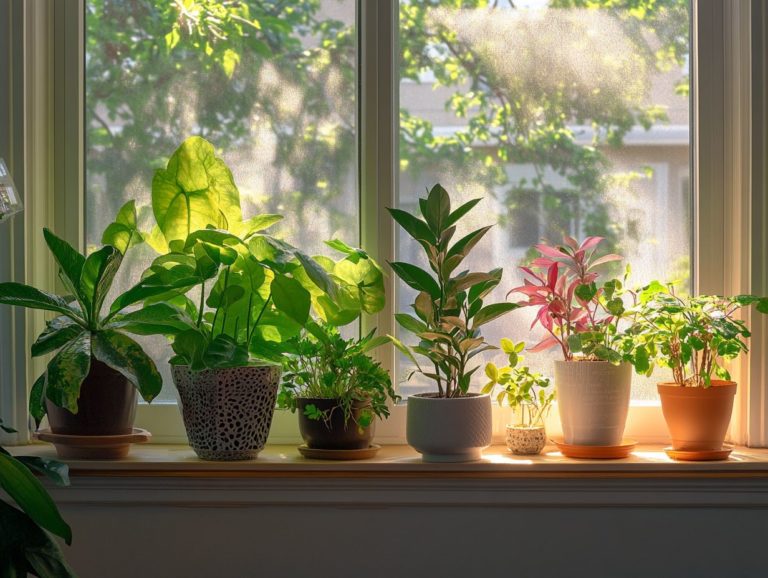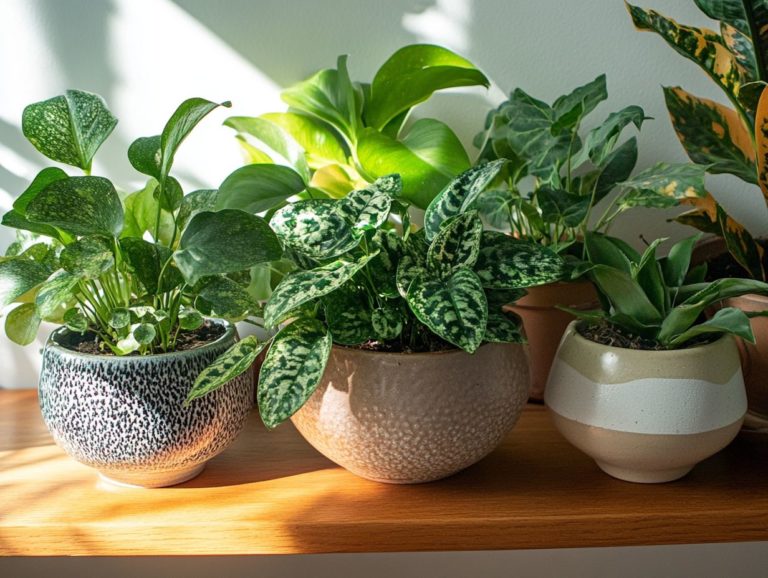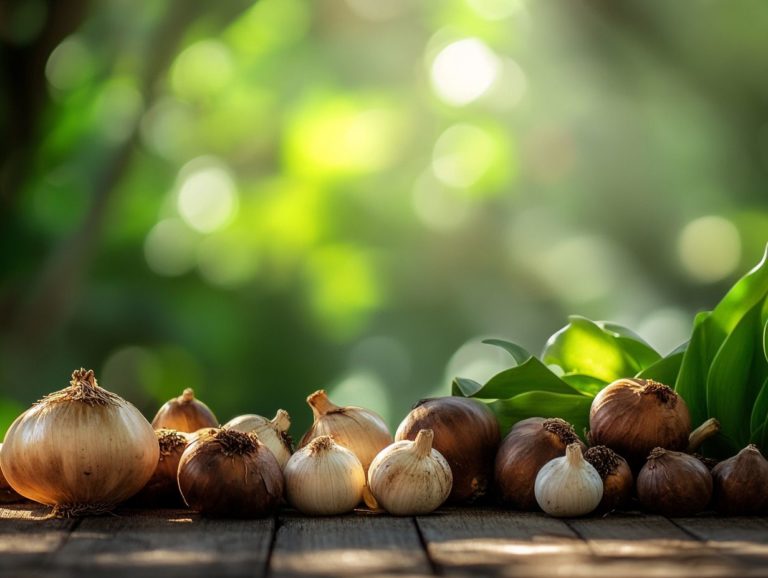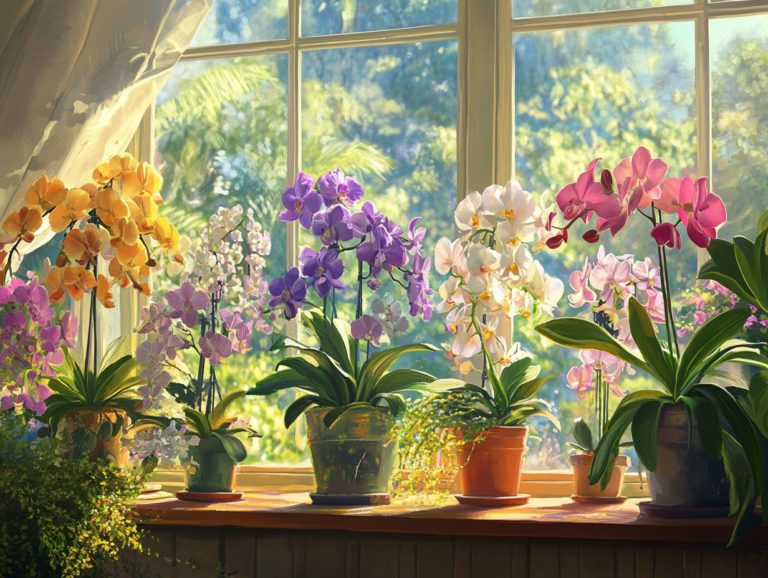Adjusting Lights Based on Plant Growth
Plant growth is intricately tied to light, making it essential for you, whether a gardener or a plant enthusiast, to grasp how different lighting conditions impact your plants.
This exploration delves into the key factors influencing plant growth, the specific light requirements of various plants, and practical adjustments to enhance their environment.
You ll discover the nuances of utilizing natural sunlight and selecting the right artificial lighting options, along with essential tools and techniques to ensure your plants thrive.
The discussion will guide you on monitoring your plants’ progress and adapting your lighting strategy as needed. Get ready to transform your space into a vibrant indoor garden filled with life!
Contents
- Key Takeaways:
- Understanding Plant Growth and Light Requirements
- Common Light Adjustments for Optimal Plant Growth
- Tools and Techniques for Adjusting Lights
- Monitoring and Maintaining Light Adjustments
- Frequently Asked Questions
- What are the benefits of adjusting lights for plant growth?
- How do I know if I need to adjust the lights for my plants?
- What are the different types of lighting that can be adjusted for plant growth?
- How do I adjust the lights for my plants?
- What are some signs that indicate the lights need to be adjusted for my plants?
Key Takeaways:
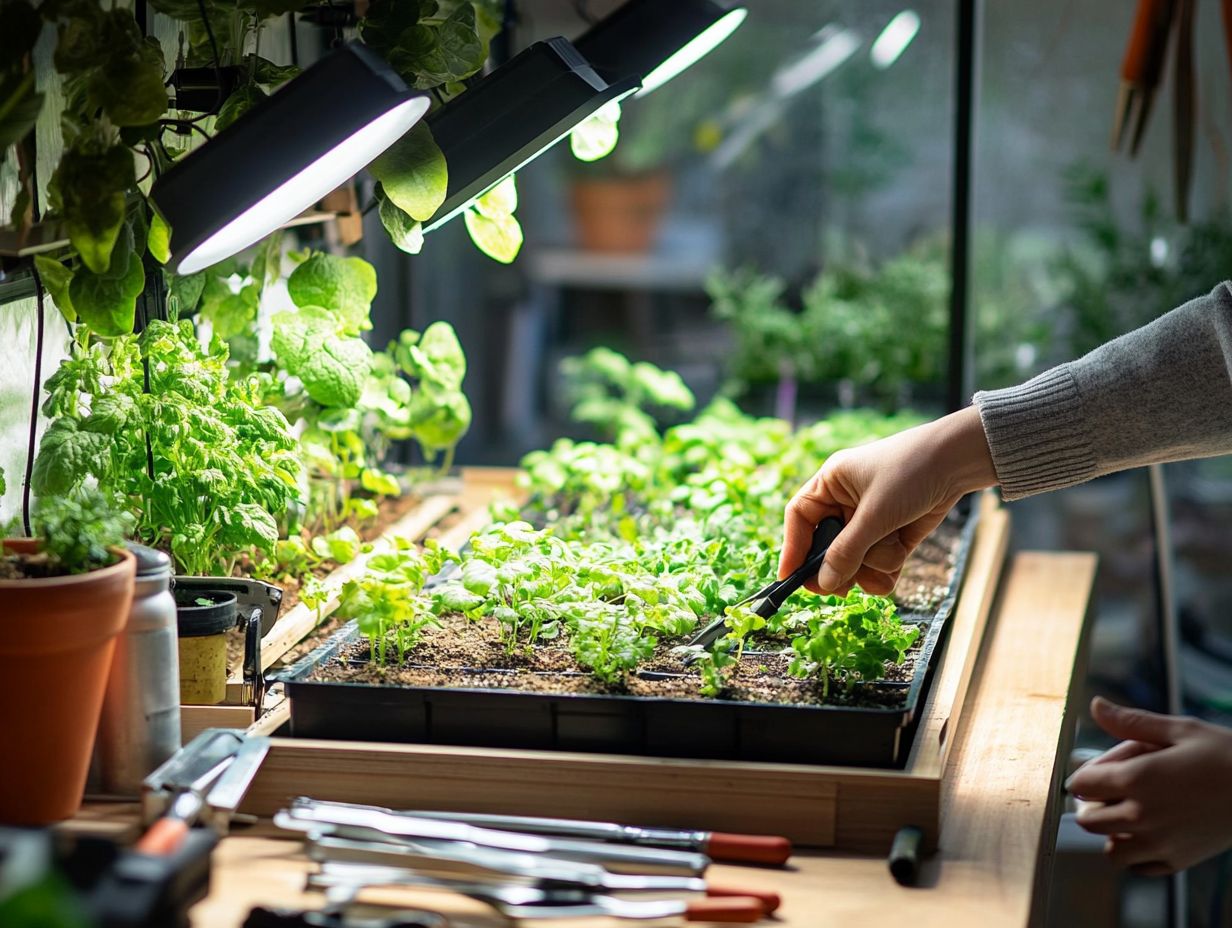
- Adjusting light intensity and energy output is crucial for promoting optimal plant growth, as different plants require different levels of light.
- Changing the light spectrum and chlorophyll absorption, through natural sunlight or artificial lighting options, can provide specific wavelengths necessary for plant growth.
- Regularly monitoring and adjusting lights based on plant growth and health is essential for maintaining healthy and thriving plants.
Understanding Plant Growth and Light Requirements
Understanding plant growth and the specific light requirements for various species is paramount for your success in indoor gardening. Different plants be it succulents and cacti or flowering varieties and leafy greens exhibit distinct responses to light intensity and spectrum, which are vital for processes such as photosynthesis and chlorophyll absorption.
By selecting the right LED grow lights, fluorescent lights, and other grow lights, including full-spectrum bulbs, you can create optimal growth conditions for your plant collection. This approach not only fosters vigorous growth but also enhances their overall health, ensuring your indoor garden thrives.
Factors Affecting Plant Growth
Several factors significantly influence your plants’ growth, with light intensity and quality standing out as some of the most critical elements. Ensuring adequate light duration (the amount of light your plants need each day) and the right light spectrum can enhance photosynthesis, promoting optimal chlorophyll absorption and overall health for your indoor plants.
Light not only fuels the photosynthetic process but also affects the rate of flowering and fruiting in various species. Besides light conditions, temperature plays a vital role; for instance, most houseplants thrive in a stable, warm environment, while certain flowering varieties flourish with cooler temperatures during their nighttime cycles.
Moisture levels interact closely with these conditions; insufficient hydration combined with poor lighting can lead to stunted growth and diminished vitality. Understanding how these factors work in harmony is essential for nurturing healthy, flourishing plants in any setting.
Types of Light Required for Different Plants
Different plants have distinct lighting needs for optimal growth, categorized as low, medium, and high light requirements. By utilizing suitable grow lights, such as LED grow lights and full-spectrum grow bulbs, you can effectively meet the diverse light spectrum demands critical for photosynthesis.
Understanding these specific needs enables you as a plant enthusiast to cultivate a thriving indoor garden. Low-light plants, like snake plants and pothos, flourish in indirect sunlight and are perfectly content in corners with minimal illumination. On the other hand, medium-light lovers, such as peace lilies and ferns, thrive in brighter spaces without direct exposure. High-light varieties, like succulents and tomatoes, require direct sunlight or intense artificial lighting to truly excel.
By tailoring your grow lights to these categories, you not only support healthy growth but also maximize yields for flowering plants. Providing the essential red and blue light spectrums is crucial for the budding and flowering stages, ensuring your plants reach their full potential.
Start your journey today and watch your plants thrive!
Common Light Adjustments for Optimal Plant Growth
Making subtle light adjustments is essential for nurturing optimal plant growth and creating the ideal conditions for photosynthesis and chlorophyll absorption. You ll want to carefully manage light intensity, fine-tune the light spectrum, and control the duration of your artificial lighting.
This approach enhances energy efficiency and promotes the overall health of your plants.
Adjusting Light Intensity
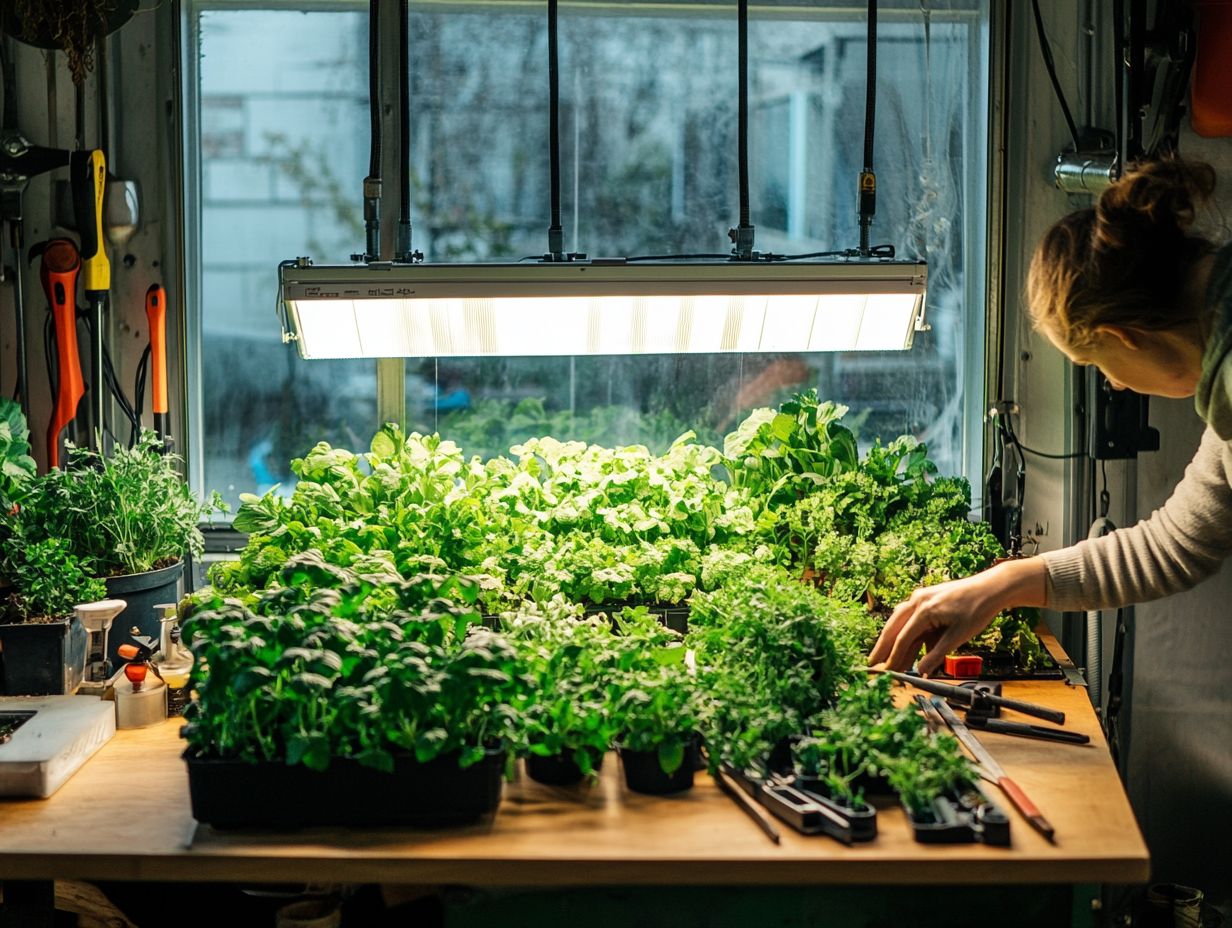
Adjusting light intensity is key for optimizing plant growth. Your plants need adequate energy for photosynthesis. By utilizing energy-efficient grow lights, you can make indoor gardening more effective. The right intensity can enhance the health and vigor of your plants.
To create perfect light conditions, easily manipulate the distance from the light source or explore various dimming options. For example, positioning lights closer can benefit seedlings and germinating seeds craving higher intensity. Properly dimming lights can support houseplants that thrive under moderate levels, while also considering measuring the effect of light on plant growth.
Understanding these nuances is crucial, as different plants respond uniquely to light. Seedlings often need brighter, more direct light for robust development, while established houseplants can suffer from light stress if exposed to excessive intensity.
To measure light levels accurately, handy tools like a light meter can help you determine optimal exposure, promoting a lush and thriving indoor garden.
Changing Light Spectrum
Changing the light spectrum greatly affects the health and growth of your plants. Different wavelengths like red and blue light serve unique purposes in the photosynthesis process. Using specialized grow lights to adjust this spectrum is essential for catering to the specific needs of your indoor plants.
Red light plays a vital role during the flowering stage, encouraging blooming in plants such as tomatoes and strawberries. Meanwhile, blue light is critical for vegetative growth, fostering robust foliage in leafy greens like lettuce. Far-red light helps regulate growth patterns and can enhance flowering when paired with red light.
Opting for grow fixtures equipped with full-spectrum LEDs ensures that your plants receive a balanced blend of these wavelengths, promoting targeted growth at various stages. Lighting considerations for plant growth allow you, as an indoor gardener, to maximize yield and cultivate healthier plants.
Manipulating Light Duration
Manipulating light duration, or how long plants are exposed to light, is crucial to maximizing photosynthesis and enhancing plant growth. By controlling the duration of light exposure with grow lights, you can effectively influence flowering cycles and overall plant health in your indoor garden.
Different plant species respond uniquely to various light durations. Some thrive under extended periods of light, while others need specific dark cycles to trigger blooming. For example, long-day plants may show vigorous vegetative growth with more hours of light, whereas short-day species often start to flower as the days shorten. To optimize growth, consider creating a light schedule for different plants.
To meet these diverse needs, using timers and establishing a consistent light schedule can significantly improve your gardening outcomes. By strategically adjusting your light exposure routines and identifying the light needs of various plants, you can create an optimal environment tailored to each plant’s lifecycle, promoting robust growth and vibrant blooms throughout their growing seasons.
Tools and Techniques for Adjusting Lights
Utilizing the right tools and techniques for adjusting lights is crucial for achieving optimal plant growth. Choosing the right grow lights can transform your gardening experience! Incorporate a variety of light fixtures and vintage tins, and consider energy-efficient options that will enhance your plants’ health and contribute to a sustainable gardening environment.
Using Natural Light Sources
Using natural light sources effectively is essential for successful indoor gardening. They deliver the quality and energy efficiency that plants crave. By positioning your plants near windows or light wells, you can maximize their sunlight exposure, promoting overall health and vitality.
It s exciting to explore how light changes throughout the day! South-facing windows usually provide the brightest conditions, while north-facing ones offer gentler, indirect light perfect for sensitive plants. For optimal placement, consider using reflective surfaces, like mirrors or shiny materials, to amplify the natural light in your space.
When it comes to window treatments, choose wisely! They help you control sunlight intensity while shielding delicate plants from scorching rays. If natural light is lacking on overcast days or in dimly lit rooms, don’t hesitate to integrate artificial lighting like grow lights. This addition can effectively supplement the types of light essential for your indoor plants, as detailed in the science of light and plant care, to thrive.
Artificial Lighting Options
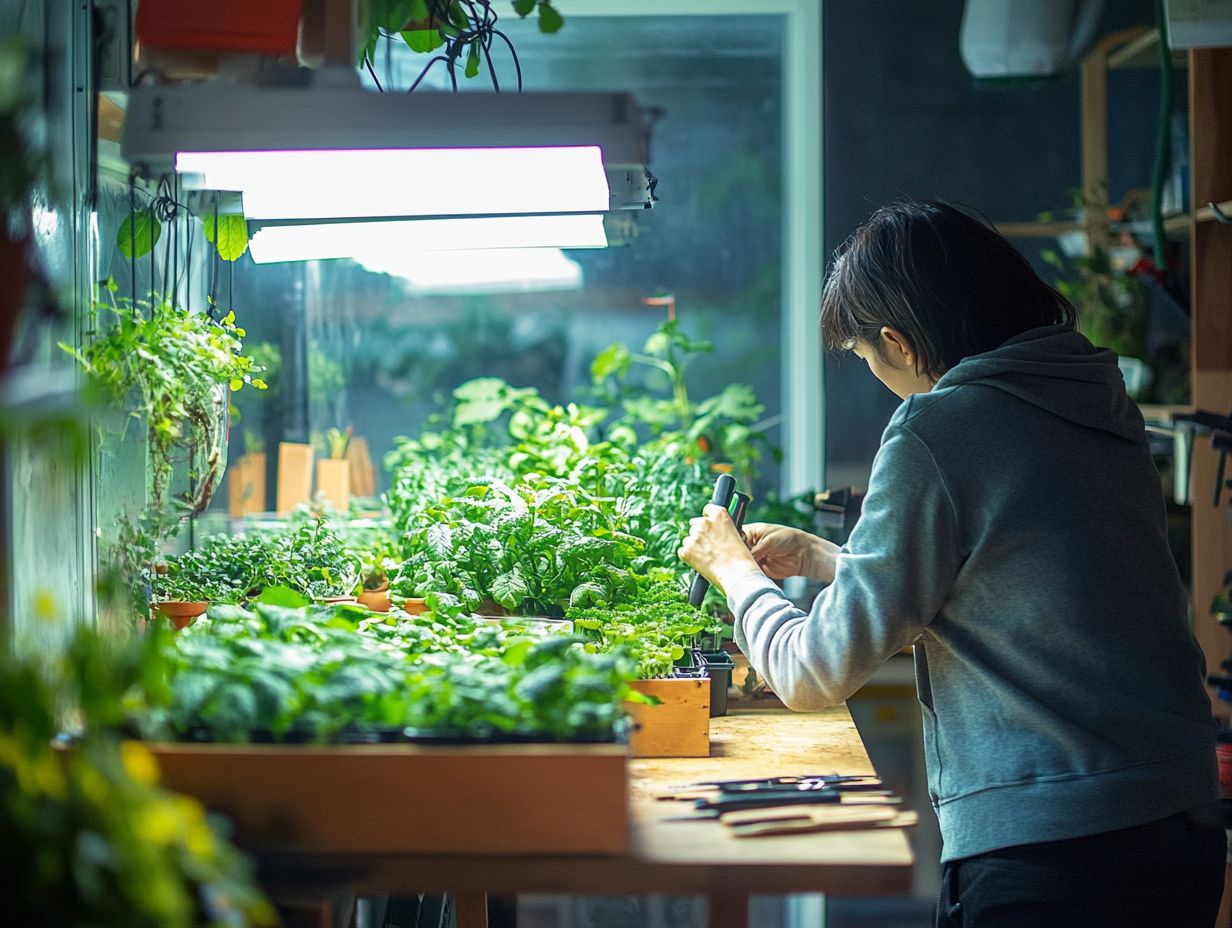
Artificial lighting options, such as LED grow lights and specially designed fixtures, play a critical role in nurturing healthy plant growth indoors. These technologies provide energy efficiency and the versatility needed to meet the unique light requirements of various plant species.
You’ll find several popular types of artificial lighting: LED, fluorescent, and incandescent. LEDs are favorites due to their low energy consumption and impressive lifespan. They offer a full spectrum of light suitable for various growth stages. To ensure your plants receive the proper light, learn how to keep track of plant light needs. Fluorescent lights emit a softer glow that’s perfect for seedling growth and are generally more budget-friendly. Meanwhile, incandescent lights may provide warmth, but their high energy usage and limited lifespan make them less suitable for long-term plant care.
By understanding these options, you can select the ideal lighting solution tailored specifically to your indoor garden needs.
Monitoring and Maintaining Light Adjustments
Monitoring and making subtle adjustments to light conditions is essential for ensuring that your plants achieve their fullest potential in growth and health. Regularly assessing the lighting environment and making timely modifications can significantly enhance energy efficiency and elevate your indoor gardening experience.
This proactive approach nurtures your plants while allowing for a more refined management strategy in your gardening endeavors.
Regularly Checking Plant Growth and Health
Regularly checking the growth and health of your plants is crucial for thriving indoor gardening. This practice allows you to make timely light adjustments that can significantly enhance energy efficiency. By observing changes in their appearance, you gain vital insights into their light needs and overall condition.
Healthy plants typically flaunt vibrant, deep green foliage, exhibit robust growth, and display a steady upward trajectory. These signs indicate they re basking in the right amount of light and nutrients. Conversely, if you notice yellowing leaves, stunted growth, or wilting, it’s a clear signal that your plants need immediate attention.
To effectively assess plant health, take a moment to evaluate leaf color, the rate of new growth, and overall vigor. Maintaining optimal lighting conditions requires consistent monitoring of light intensity and duration, ensuring that your plants aren’t under- or overexposed. Simple adjustments like repositioning your plants or using adjustable grow lights can make a world of difference in their well-being and growth trajectory. For more in-depth tips, check out our guide on how to create a light schedule for plants.
Start observing your plants today to see what they need!
Adjusting Lights as Needed
Adjusting the lighting as needed is essential for nurturing plant growth and ensuring your indoor plants thrive in the best conditions. Regularly evaluating and modifying light intensity and duration can significantly boost energy efficiency.
Look out for signs that indicate it’s time to adjust the light. If you notice stretched stems that indicate the plant needs more light, yellowing leaves, or stunted development, your plants might be craving more light. For effective care, be sure to monitor light exposure for healthy plants. Conversely, if the leaves appear scorched or crispy, it may indicate that the lighting is too intense.
To effectively tailor the light conditions, consider the specific needs of each plant type. For example, succulents bask in bright light, while ferns prefer a more subdued setup. Understanding plant light adaptation can help you create the ideal environment for your greenery.
As your plants progress through their growth cycles, their lighting requirements may evolve. It’s a good idea to reassess their environment periodically. Experimenting with different light sources, whether LED or fluorescent, can also help you strike the perfect balance for vibrant growth.
Frequently Asked Questions
What are the benefits of adjusting lights for plant growth?
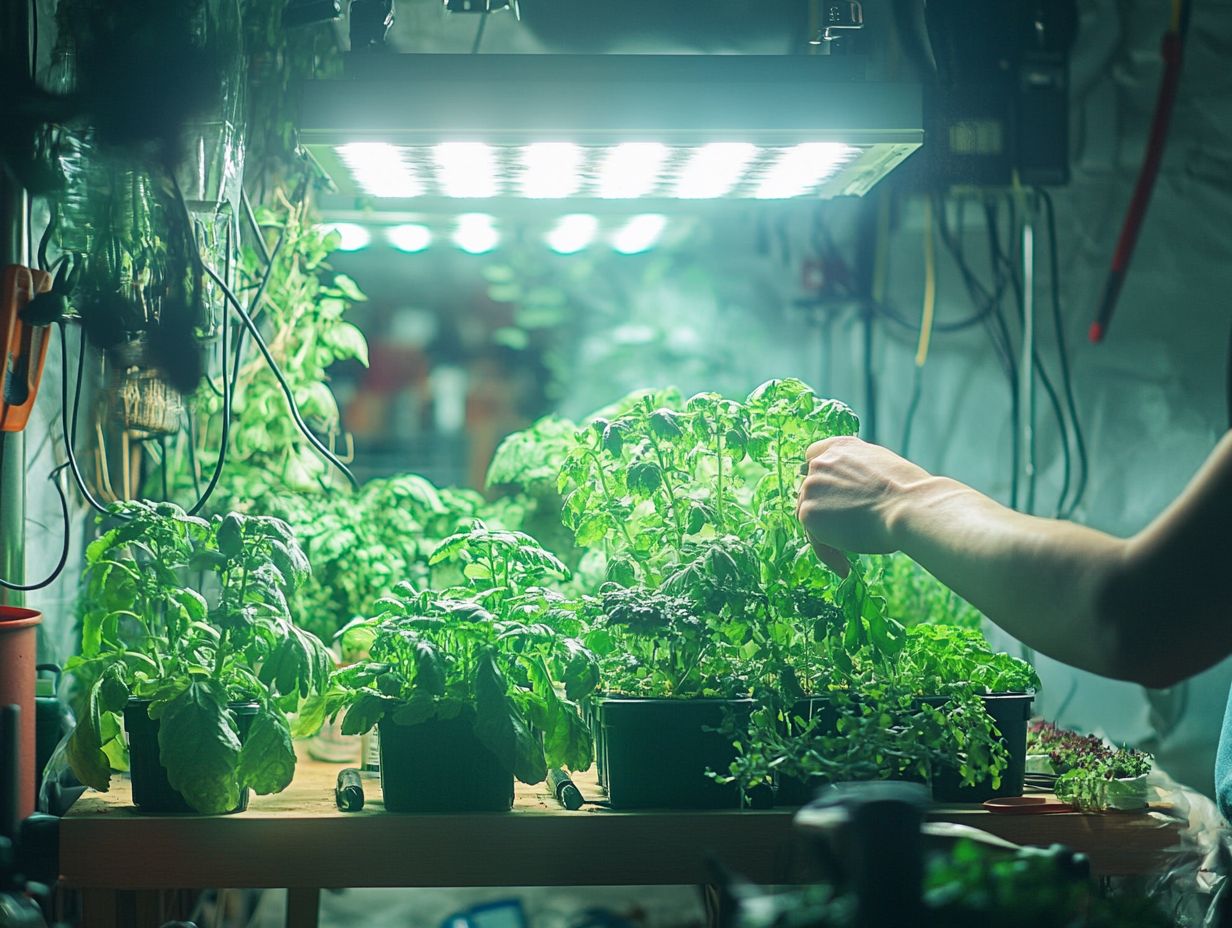
Adjusting lights helps your plants grow stronger and healthier by providing the right amount and type of light necessary for optimal growth and development.
How do I know if I need to adjust the lights for my plants?
You may need to adjust the lights for your plants if they are not growing as expected, showing signs of stress, or not producing enough flowers or fruit.
What are the different types of lighting that can be adjusted for plant growth?
The different types of lighting include natural sunlight, fluorescent lights, LED lights, and high-intensity discharge (HID) lights.
How do I adjust the lights for my plants?
The procedure for adjusting lights depends on the type of lighting being used. Generally, ensure the lights are placed at the appropriate distance and intensity to provide the required light for specific plant species.
What are some signs that indicate the lights need to be adjusted for my plants?
Some signs include leggy or elongated stems, yellowing or browning leaves, stunted growth, and lack of flower or fruit production.
Now that you know how to adjust your lights effectively, don’t hesitate to experiment and see what works best for your plants! Share your results with fellow plant enthusiasts and enjoy a thriving indoor garden!

